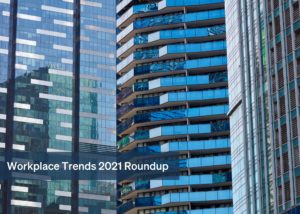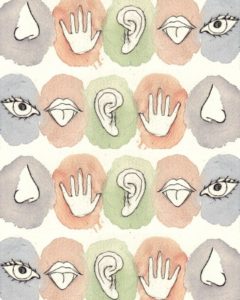Workplace Trends October conference was going so well, with plenty of thought-provoking content and then, it was knocked out to those attending virtually by a broadband outage in the local area.
But what of the conference itself?
Nigel Oseland got the ball rolling with some snippets from his new book Beyond The Workplace Zoo. Since Covid hit, Nigel has been on a crusade to de-densify workplaces – and for that he is to be applauded. But not just spacing desks further apart, adding some colour and shade, mixing things up and creating an Agile Landscaped Office. Given free reign, it’s what our designers would do anyway.
Swiss-based Studio Banana were a name new to us at SPACE – judging from their mini-showreel, they’ve done some really nice projects. They presented on the in-between spaces, bridging the gap from home office to head office. Key Kawamura gave us some examples, including Hoffice – a concept we’d never heard of – where colleagues choose to co-work in one of their homes. I’m not sure how many of us (a) have the space and (b) love our colleagues that much! An interesting quote from Key: “Culture can’t only be dependent on physical location.”
In amongst the slick PowerPoint presentations was Kirk Vallis from Google who took a step back from workplace and discussed creativity in general (with a suitably ‘lo-fi’ slide deck). He emphasised the importance of the cognitive cleanse and the need to engineer-in deliberate distractions and serendipitous interactions in the workplace. He portrayed the cartoon character ‘Super Busy,’ which I’m sure many can relate to, with the catchphrase ‘busy is the new stupid,’ advocating none of us can really high perform when multitasking! Let’s scrap our To Do Lists and start our To Think About Lists!
The key takeaway from Paul-Jervis Heath’s talk on Reimagining the Workplace was that the 3:2 split between office and home – that seems to be the current default attendance model – is an amalgam of all the pre-Covid and lockdown problems. During this period of a selective return to the office we need to think carefully as to what happens next. Workplaces need to inspire, and organisations need to live their values rather than just tell people what they are – replace status of the nation Townhall talks (these can go on dashboards) with what the vision of the future is.
Michael Fern from Edge added a more commercial feel to the morning’s presentations by talking about brand and storytelling, linking these to Edge’s work with Costa and a new Soho-based co-working space. By understanding the customer, you’re able to better craft experiences for them. Start with why people would want to go to a space and look at how the space functions. Then, incorporate brand (and purpose) to create the experience. User experience – connecting the brand to the environment (and vice versa) – is not new design thinking but we welcomed hearing this within a workplace conference to balance the theory and statistics with the design.
Workplace Trends always like to have a little pre-lunch whimsy and this conference was no different. Cue a Dr Seuss-themed poem on the highs and lows of workplace design delivered with gusto by Sally Augustin and Vanessa Champion (The Space Doctors).
With a nod to the post-lunch pitfall of Death by PowerPoint, the next two presentations were discussions. The first was moderated by James Lawrence of Gensler with input from workplace strategists from two of their recent clients (Tetra Pak and Vodafone). Mirna Gelleni (Vodafone) re-iterated the need for a more nuanced attendance model than the blanket 3:2 approach and stated that enticing people to return to the office was more than offering them free lunch (the cost of the commute and the time taken was just not worth it). It was interesting to note that Vodafone are not seeing people flooding their offices at the moment. Sudhir Saseedharan (Tetra Pak) said that future ways of working would evolve and be modified over time. His organisation, coming from the more traditional end of the spectrum, were embracing a new service offering within the workplace – a consistent smell via the food offering in their offices to encourage people back (in contrast with Mirna’s comment). Solutions were being developed through lots of engagement. Sudhir highlighted the benefit of a more distributed workforce, with flexible working policies potentially widening the talent pool. Essentially, it’s now a global rather than just local talent pool, and this creates opportunities for growing a more diverse and inclusive workforce.
There was a discussion on homeworking ergonomics led by Herman Miller’s Mark Catchlove (Lillian Antonio, a qualified ergonomist (no, we didn’t know you could get a degree in it either) laid the blame for our aches and pains squarely on laptops. Far too many people 18-months in are still using their laptop keyboard, with the kit itself sitting flat on the work surface causing people to hunch while working. Poor seating came in second place. We can do so much better. As employers, we have to ensure that anyone working from home on a regular basis can do so safely and comfortably. Get up, stand up.
Chely Wright of Unispace brought a touch of Nashville (via New York) to the conference. A former Country & Western singer, Chely told us that implementing Diversity, Equity (not Equality) and Inclusion (DE&I) was not just the right thing to do, but it was the only thing to do.
And then it all went quiet in the virtual world…
Those of us attending in person were swiftly moved to the penultimate talk by the engaging Dhanistha Patel (CBRE), highlighting the need for understanding the differences within the intergenerational expectations from the workplace. For the first time in history, we’re a workforce across five generations: from Baby Boomers working longer past retirement age to Gen X and Y (millennials) to GenZ, our ‘digital natives,’ who crave human and personal interactions, and value humanity, strategy and ethics highest when seeking a company to work for or with. Echoing Chely’s talk on DE&I, Dhanistha spoke about what GenZ want in an organisation. With 65% of job seekers considering workplace diversity an important factor in an employment opportunity, she urged companies to ensure their values, ethos and Boards were more reflective of what the GenZ workforce look for. Basically, don’t just put lip-service to DE&I but instead, actively recruit and promote for a DE&I leadership and workforce.
The final talk took the perspective of the recruiter, with The Talent Locker’s James Saunders discussing what he’s seen from the market over the past 18-months and how to make yourself stand out both as an interviewer and an interviewee. With UK job vacancies at a 20-year high, gone are the days that people will accept a 5-stage recruitment process where the salary is only discussed on the final stage. Through the pandemic people have come to recognise their time is precious and want an open, transparent, and humanised process with a genuine role at the end. As much as it’s up to the interviewee to showcase what they can bring to the role, the onus is now very much on companies to make sure they offer a flexible and attractive role. Don’t just do the same old thing because you always have, but really showcase how you stand out and learn from your competitors.
What did we learn? What was new?
- We need to design for a range not the average and look at value not just cost
- Culture needs to be independent of the physical workplace
- We need to get away from back-to-back meetings
- Show people what your values are – telling them is not the answer
- Keep asking why – it has to be the first question
- Organisations will have different ways of enticing people back to the workplace – it’s still early days however
- After the last 18 months, the global workforce is exhausted. Businesses need their workplaces to encourage people back together for collaboration while recognising the need to design for the cognitive cleanse between meetings and focus work, allowing for happenchance of collisions, collaborations, and creativity
Not new, but re-stated…
- We need to cast the net wider on stakeholder consultation for real change
- Workplace can learn a lot from retail design as well as other sectors
- De-brief every project – measure success and if it didn’t work, understand why
- Biophilia isn’t just green potted plants but a fundamental element of spatial design
- The office should be the place where you re-charge, re-connect and learn from others
- Cater for ‘deep work’ within the workplace – concentration space in equal measures
- Design-in non-bookable space(s)
- Give folk space, more space!



